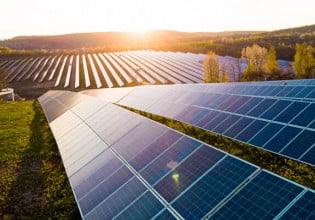Developments in Offshore Wind Speed, Wake Effect and Theft
This wind roundup examines offshore wind development in Virginia and separate studies predicting wind speed and wake effect and identifying wind theft.
U.S. regulators have approved a major offshore wind project off Virginia’s coast. Meanwhile, two studies from Canada and Norway tackle wind forecasting errors and the so-called “wake effect” phenomenon between wind farms in the North Sea.
The first two pilot turbines in the CVOW project came online in 2020. Image used courtesy of Dominion Energy
Regulators Rubber-Stamp Virginia Offshore Wind Project
Virginia-based utility Dominion Energy secured approval from the Bureau of Ocean Energy Management (BOEM) to build its Coastal Virginia Offshore Wind (CVOW) project, a commercial-scale wind farm near an existing pilot installation. The pilot came online in 2020 with two offshore wind turbines generating 12 MW for 3,000 homes off the coast of Virginia Beach. The larger expansion, situated 27 miles from shore, will unlock 2.6 GW to power 660,000 homes.
The project will comprise 176 turbines (each with 14.7 MW of capacity), three offshore HVDC substations, inter-array cables connecting the turbines to substations, and export cables buried under the seabed surface. Dominion Energy will also add onshore infrastructure, including a switching station and an overhead power line connected to the existing grid in Chesapeake. After construction concludes in 2026, the project will deliver up to 8.8 million MW annually.
Steel monopiles for the CVOW project. Image used courtesy of Dominion Energy
The first monopile foundations have recently arrived on-site and are staged until construction launches in spring 2024. The foundations, single vertical steel cylinders, will be pile-driven into the seafloor to support the generators. They’ll serve as the entry points for inter-array cables transporting power from the turbines to offshore substations.
CVOW marks the BOEM’s fifth approval of a commercial-scale offshore wind project. The agency plans to review at least 16 more projects by 2025, totaling more than 27 GW.
New Approach to Reducing Wind Speed Forecasting Errors
Researchers from Concordia University in Canada are developing a hybrid AI-based model to improve wind speed forecasting. Testing the model over a 48-hour time scale in Montreal, the researchers found that integrating deep learning with wind speed probability distribution boosted the forecasts’ accuracy to be consistent with observed seasonality and trend values.
The method draws upon outputs from Weibull probability distribution, which uses historical records and other data to predict wind speeds, and numerical weather prediction (NWP), which calculates future weather behavior based on atmospheric and oceanic data. Weather apps commonly use NWP for hourly and daily forecasts.
The researchers entered the Weibull probabilities into a long short-term memory (LSTM) model, a neural network architecture used for time-series analysis. They then added NWP data to improve the method. Tests yielded a 13% to 31% reduction in forecasting errors across three seasons (summer, fall, and winter) compared to the non-hybridized LSTM.
One of the authors, Fuzhan Nasiri, emphasized the importance of precise wind speed data. This information can pinpoint areas with the greatest potential to ensure turbines operate with high efficiency.
Different models forecast results for 48 hours in three seasons. Image used courtesy of the authors (Creative Commons)
Due to renewables’ intermittency and volatile fluctuations, existing models are limited in anticipating wind power generation. For example, the LSTM model falls short in making precise predictions, especially during abrupt surges or unexpected shifts.
However, by combining Weibull distribution probabilities with a single LSTM model, the researchers achieved significant error reduction, averaging 28% across three prediction periods. The researchers hybridized their NWP results into the LSTM-Weibull integrated framework to account for unexpected wind behavior missing from historical data. The final model reduced errors by 32%, considering fluctuations in the central peaks.
Transboundary Wakes Allow Wind Theft
Researchers at Norway’s University of Bergen have found that neighboring offshore wind farms can steal each others’ output from 31 miles away due to wake effects. This phenomenon occurs when wind passes through one turbine and leaves turbulence in its wake, which then reduces production for other turbines located downwind. Affected wind farms may face capacity factor losses as high as 20%. Increased turbulent wind loading could also impact the turbines’ fatigue life.
Even a 5% reduction in capacity can hurt development incentives, the researchers noted, and existing regulations are insufficient to address these risks. The research comes as offshore wind development is heating up in the North Sea. However, satellite data already shows evidence of wake patterns in the region.
Satellite imaging shows mean wind speed above the sea surface on the southeastern bight of the North Sea. Wind farm-induced wakes (seen in the darker areas) span several miles downstream of the turbines (white dots). Image used courtesy of the authors (Creative Commons)
The Norwegian government plans to build offshore wind farms in the Sørlige Nordsjø II (SN2) area, 13.6 miles southeast of a Denmark-owned wind park, Nordsren III, in Danish waters. The researchers reviewed reanalysis data from 1992 to 2020, finding that a wind farm-induced wake effect could occur regularly from SN2 into the Danish development zone and vice versa. Climatology data indicated that a long-term wake—enabled by stable atmospheric stratification—would be commonly observed near the SN2 site with 20% to 50% frequency, depending on the wind’s direction.
Existing regulations don’t account for this phenomenon. Offshore wind resource extraction is briefly mentioned in the United Nations 1982 Law of the Sea Convention, which covers international maritime activities. The law doesn’t impose explicit limitations or guidance on other aspects of extraction, including cross-border wake effects.










